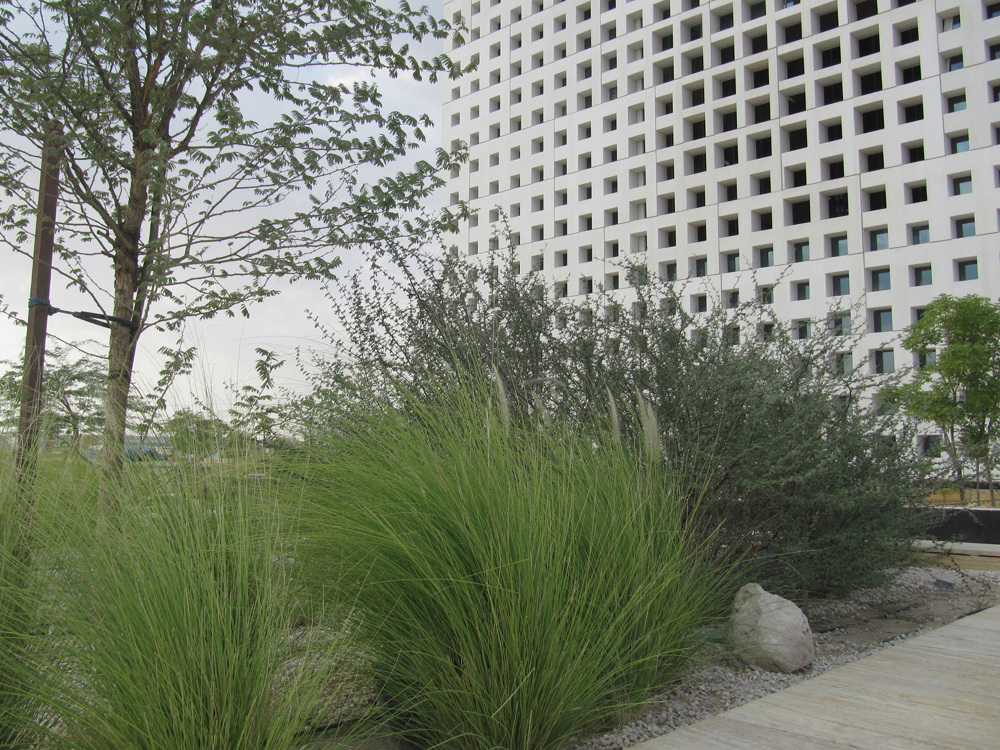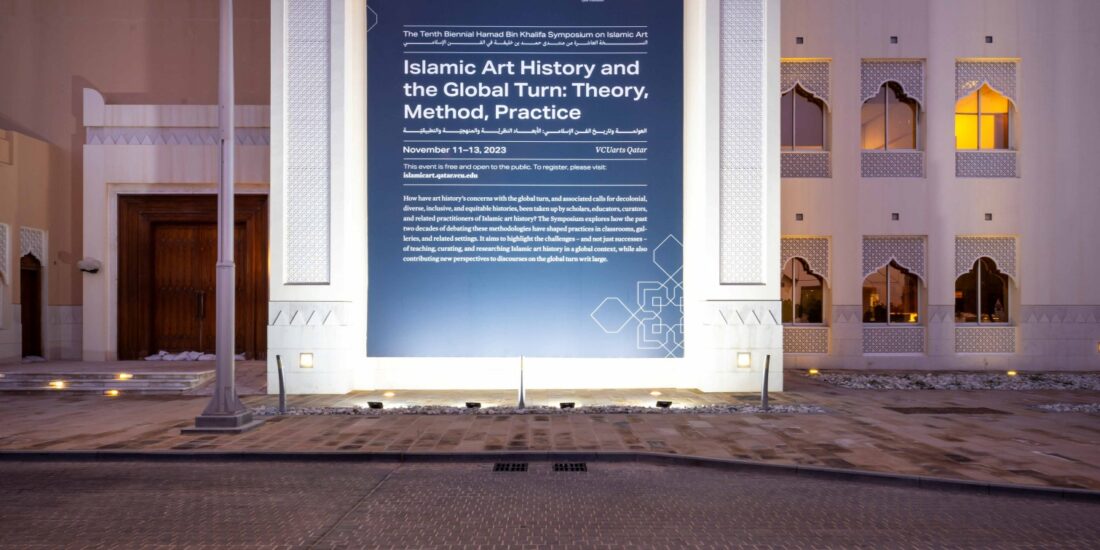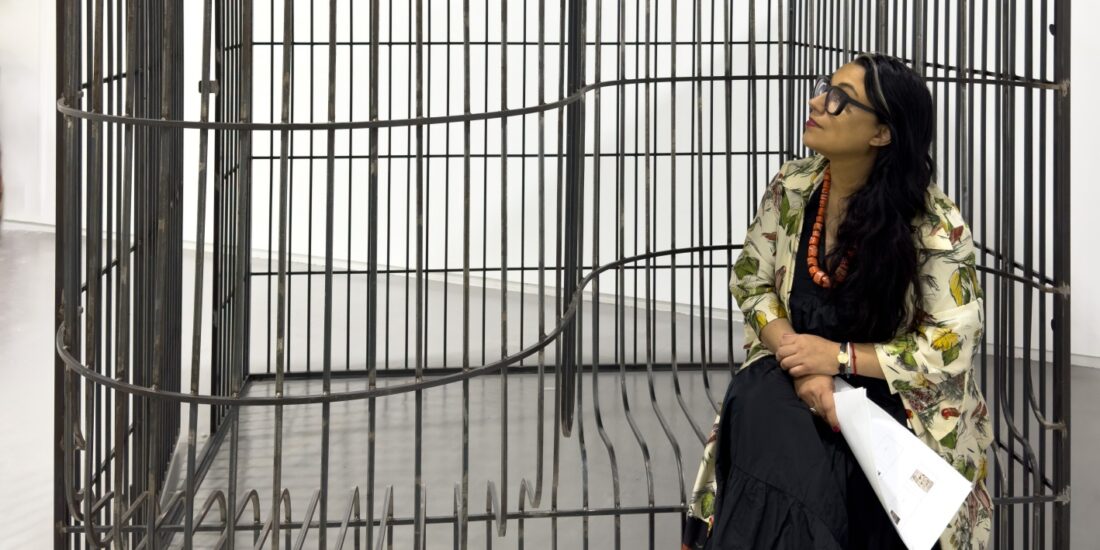Creating Environments Inside and Outside
We are delighted to put the spotlight on Dutch multidisciplinary designer Petra Blaisse, founder of the Amsterdam-based firm Inside Outside, named for its focus on projects addressing both interior and exterior spaces. Over the last 30 years, Blaisse and her team have specialised in textile, exhibition, landscape design and interior architecture. But do you know what makes Blaisse even more dear to us? It is her work within and outside Qatar National Library and in the Education City campus. By Sindhu Nair
Petra Blaisse started her career in 1978 at the Stedelijk Museum in Amsterdam, in the Department of Applied Arts and later worked as a freelance exhibition designer and won distinction for her installations of architectural works. Gradually her focus shifted to the use of textiles, light and finishes in interior space and, at the same time, to the design of gardens and landscapes and she has made a name for her ingenuity in design and process.
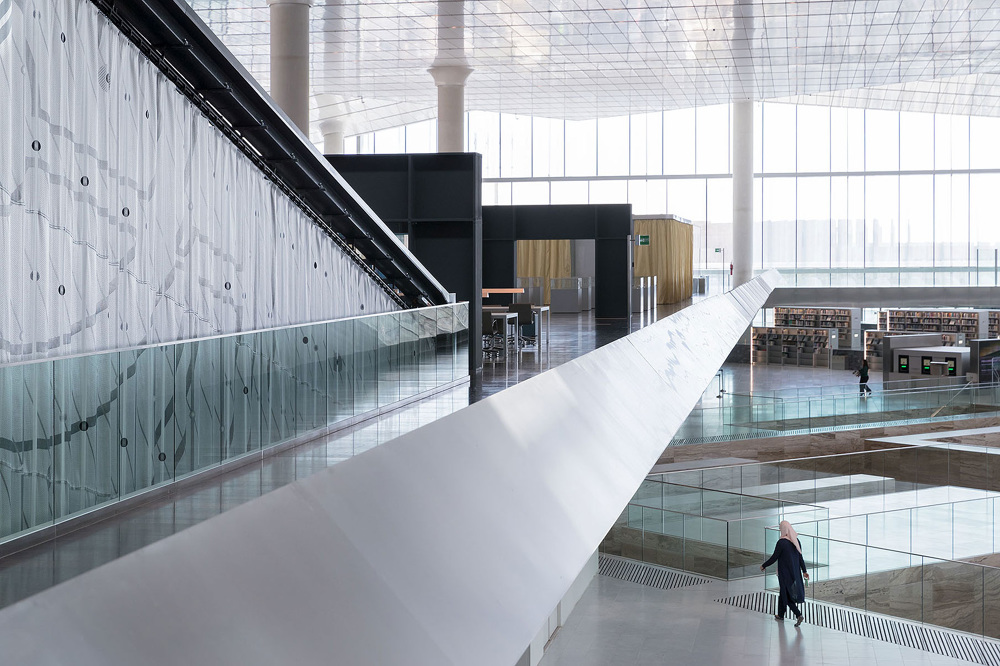
This gigantic ‘Cosmic Curtain’ within Qatar National Library, with its 700 m2 of fabric, expands the concept of a curtain, turning it into a fundamental piece of the interior architecture.
In 1991, she founded Inside Outside and through the years, the studio has collaborated with various architects and designers. In Doha, one cannot miss Cosmic Curtain, designed by this firm, at the much-loved public library. the Qatar National Library. White and undulating from the library-space, the curtain is designed as a track configuration that runs parallel to the stairs, envelopes and closes off the inside void to create a theatre-like space within with the stairs becoming the seating. This gigantic ‘Cosmic Curtain’, with its 700 m2 of fabric, expands the concept of a curtain, turning it into a fundamental piece of the interior architecture.
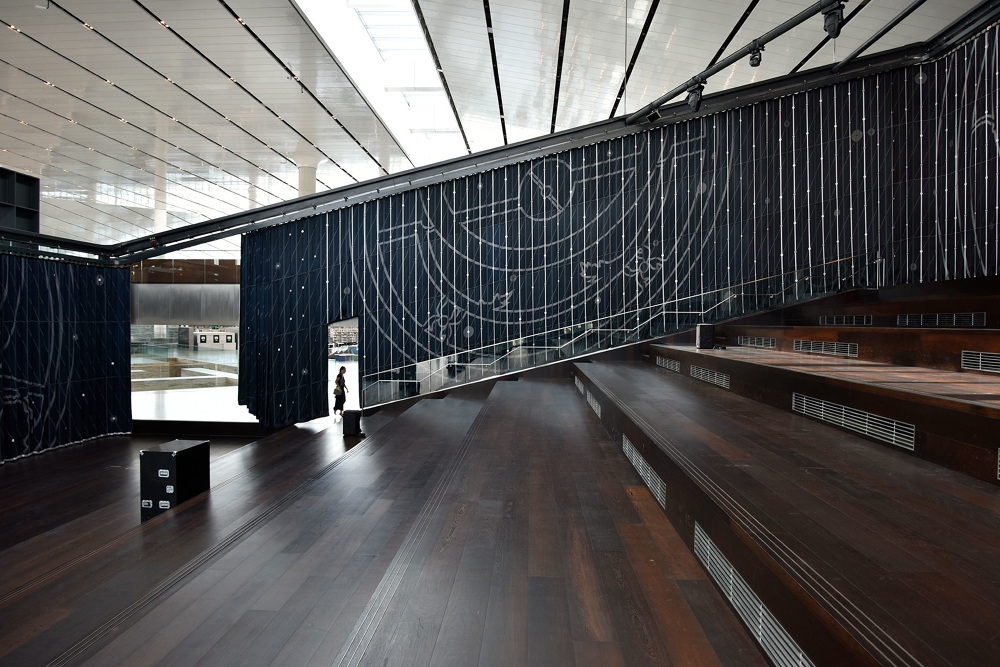
The curtain while it seems a mere functional material had to click many boxes, ease of use, and aesthetics while in use and when not in use as well.
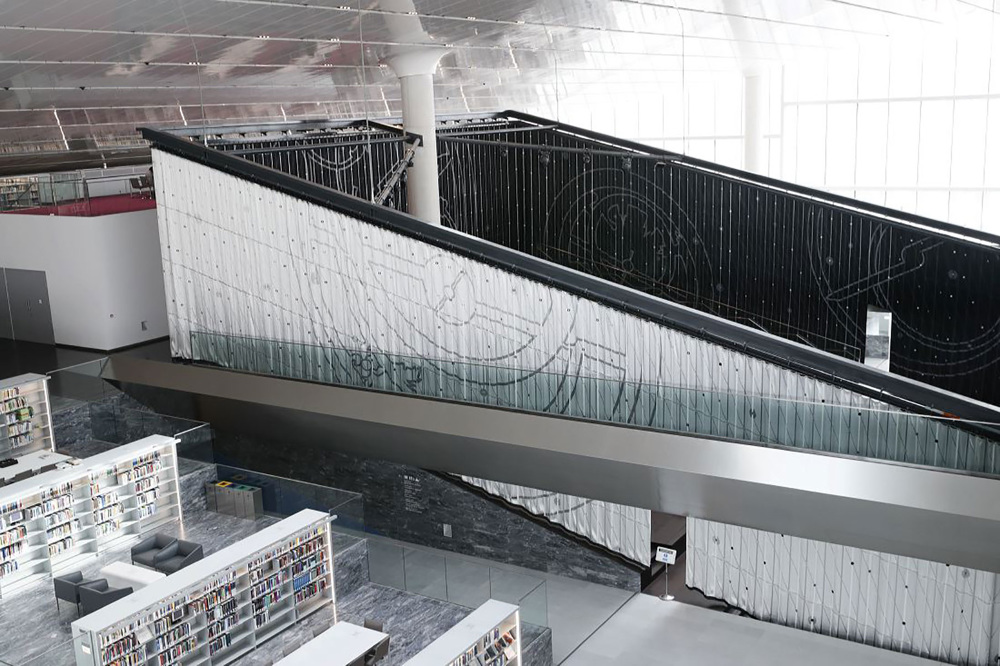 “The big challenge of this projects was to weave a fabric that is flexible enough to be pulled along horizontal and diagonal rails. Together with the TextielLab in Tilburg we explored the technical possibilities. The curtain needed to look good and move easily in every direction, including a slanted section along the stairways,” explains the designer.
“The big challenge of this projects was to weave a fabric that is flexible enough to be pulled along horizontal and diagonal rails. Together with the TextielLab in Tilburg we explored the technical possibilities. The curtain needed to look good and move easily in every direction, including a slanted section along the stairways,” explains the designer.
Finally, a loose weave with a firm and smooth weft letting the fibres slide vertically across each other for the necessary flexibility was decided and circles woven into the fabric to keep the loose material together without restricting the supple fall of the curtain. To give the curtain extra stability, ribs in a rhythm of 25 cm, were woven in the fabric.
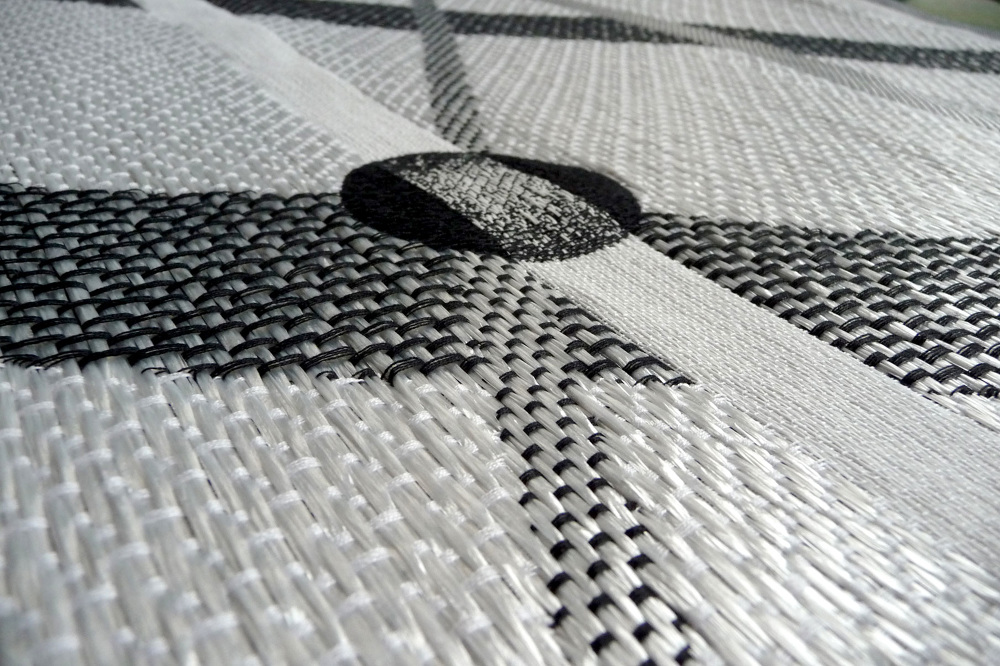 “In this weave the yarn must tick many boxes: shiny, smooth, strong, durable, colourfast, non-shrinking, crease-resistant and fire retardant. We choose a viscose raffia with a deep metallic sheen, a crinkly texture and audible rustle,” says Blaisse.
“In this weave the yarn must tick many boxes: shiny, smooth, strong, durable, colourfast, non-shrinking, crease-resistant and fire retardant. We choose a viscose raffia with a deep metallic sheen, a crinkly texture and audible rustle,” says Blaisse.
Along the inside of the curtain the colours shift from deep black to dark blue, with planets and stars in different shades of silver. The outside of the curtain reveals the same damask pattern, but variations in the weft mean that the fabric on this side is almost completely made up of whites in shiny and matt yarn. Light on the outside, dark on the inside: the two sides are as different as night and day and they make an excellent choice for a divider.
It is from this one commission that we understand the scope of detailing of the firm, the importance of materiality, to aid in function as well as in aesthetics to yield the desired effect.
 For the landscape outside the QNL Building, Inside Outside proposesd a simple garden recipe: a group of circular imprints into the soil, planted with families of three different types of drought tolerant vegetation: Acacia, Euphorbia and Agave.
For the landscape outside the QNL Building, Inside Outside proposesd a simple garden recipe: a group of circular imprints into the soil, planted with families of three different types of drought tolerant vegetation: Acacia, Euphorbia and Agave.
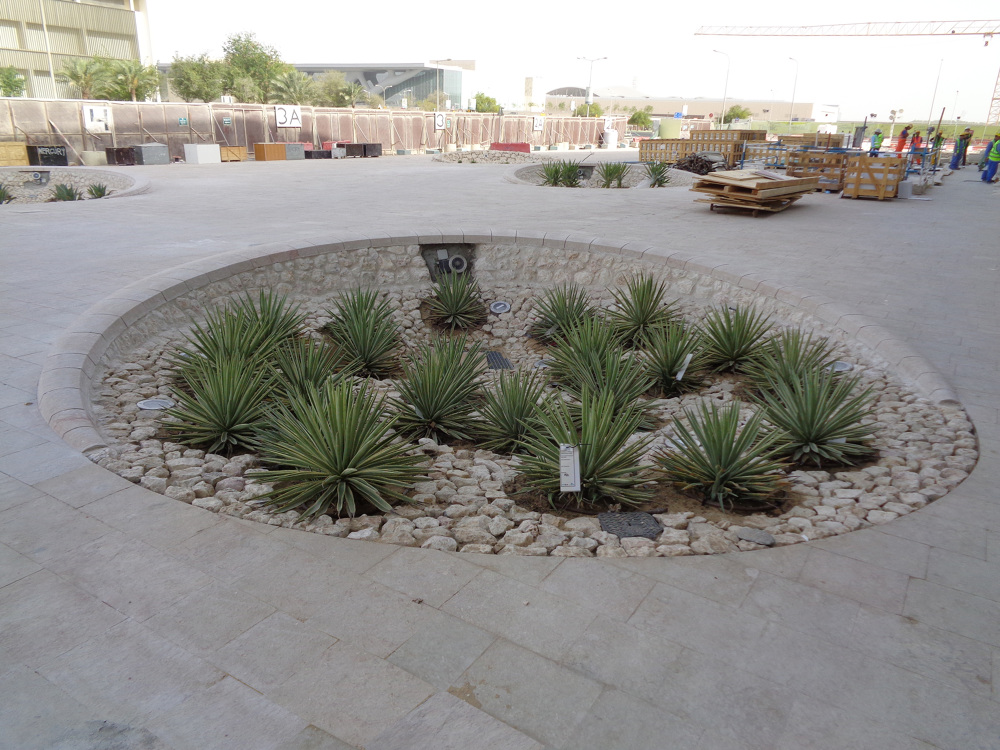 “The effect of the logic we use for the concave, circular imprints – their changing size and depth – will be, that less of the same species will grow on a higher view level in the smaller areas; and more of the same species will grow on a lower level out of the larger circular areas…thus providing surprise and change with a minimum of variation. Our aim is to water the plants, succulents and trees only in the first few years – until they have settled – and to refrain from watering the plantings after this period,” she explains.
“The effect of the logic we use for the concave, circular imprints – their changing size and depth – will be, that less of the same species will grow on a higher view level in the smaller areas; and more of the same species will grow on a lower level out of the larger circular areas…thus providing surprise and change with a minimum of variation. Our aim is to water the plants, succulents and trees only in the first few years – until they have settled – and to refrain from watering the plantings after this period,” she explains.
SCALE engages with this multi-faceted artist for an exclusive interview.
SCALE: You have traversed from art to exhibition design to the use of textiles, light and landscape design. Do you think all these various facets of design are intertwined? Do you have a particular joy when you work in any one medium?
PETRA BLAISSE: Yes. they are intertwined, because all the work we do is about creating environments. To create environments inside or outside, there are overlapping elements that play a role: time, light, climate, and human interaction, to name a few. The aspect of change and chance, the use of levels of transparency, of colours; the effect of scale; the importance of context and time; beauty.
SCALE: The firm you have started has completed many collaborative works. Which ones are most significant and why?
PETRA BLAISSE: The Re-Set installation at the Venice Architecture Biennale of 2012 was significant because it combined (almost) all characteristics that we introduced through curtains through the years: colour versus non-colour; reflection vs absorption; view vs obstruction of view; vertical vs horizontal division; transparent vs opaque; sound vs silence; movement vs stagnation; the effects of time and seasons, of day- and sunlight, of shadow-play; the effect on social interaction.

Design for the Dutch Pavilion of the Architecture Biennale in Venice: With the exhibition Re-Set Inside Outside responds to the vacant architecture in the Netherlands. Showing how the experience of space itself can be changed by relatively simple interventions, Petra Blaisse demonstrates that architecture possesses the power to start a new life.
 Then the public park we created in Milan, called Biblioteca degli Alberi that opened in October 2018. Here we created a connective park (with a ‘web’ of straight paths) at the heart of the city that includes a new form of botanic garden: a collection of trees and numerous garden typologies, combined with various play- dog- and sportsgrounds; open 24/7 and attractive in every season – a whole new park concept for Italy.
Then the public park we created in Milan, called Biblioteca degli Alberi that opened in October 2018. Here we created a connective park (with a ‘web’ of straight paths) at the heart of the city that includes a new form of botanic garden: a collection of trees and numerous garden typologies, combined with various play- dog- and sportsgrounds; open 24/7 and attractive in every season – a whole new park concept for Italy.

The park for the Municipality of Milan acts as urban connector, cultural campus and botanical garden. Paths are drawn from different areas (residential, commercial, governmental) around the site, creating a grid of connections that overlap and cross with one another.
 Now we are working on nature-inclusive high-rise buildings with different architects, and on a bio-diverse and water absorbing public park in Genoa, under the new Genova san Giorgio bridge by Renzo Piano (22 ha).
Now we are working on nature-inclusive high-rise buildings with different architects, and on a bio-diverse and water absorbing public park in Genoa, under the new Genova san Giorgio bridge by Renzo Piano (22 ha).
SCALE: In a post-Covid world do you think your sensibilities in design or the way you apply them in interiors or exhibition spaces have changed?
PETRA BLAISSE: I think the fact that work- and living spaces need more flexibility (isolation, privacy), contact with fresh air (health and prevention of contamination) and sunlight (vitamin D); the fact that offices want more exterior work, and meeting spaces; the fact that the amount of visitors to exhibition spaces are being limited to a given maximum; the obsession with security and transparency (control and overview) in all conditions inside and out; and the consciousness of the essential value of bio-diversity, CO2 absorption, economic/sustainable water- and energy management has changed the framework of our work tremendously.
SCALE: Which works by architects have affected you most?
PETRA BLAISSE: Like music, I can be inspired by any form, style, or scale of architecture, depending on moment, mood, context and weather! As a westerner, classic architecture (Greek, Roman) is studied and respected, but in all cultures (religious, political, or cultural) monuments and living quarters are impressive or at least inspiring (materials, colours, symbolic objects, decorations, building techniques, infrastructure). Troglodyte architecture (integrated in grottos, rock formations, underground etc); modernist architecture (openness, transparency, light!); architecture without architects (self-made structures) in all cultures and climate zones; architecture of re-appropriation (using / re-inhabiting existing structures). Etcetera!
SCALE: We are delighted that your work is in Doha as well. Can you tell us more about the collaboration, the final work, and your take on the QNL and the country?

 PETRA BLAISSE: We’re also delighted to work in Doha, to become part of the Education City developments and to meet such talented and educated persons such as Professor Kamal El Deen Batanouny, Professor of Environmental Sciences at Qatar University and some of his colleagues of the Botanic Department, from whom we learnt so much and who’s books on local desert plant communities we have read – the basic inspiration for the Qatar Foundation Headquarter garden.
PETRA BLAISSE: We’re also delighted to work in Doha, to become part of the Education City developments and to meet such talented and educated persons such as Professor Kamal El Deen Batanouny, Professor of Environmental Sciences at Qatar University and some of his colleagues of the Botanic Department, from whom we learnt so much and who’s books on local desert plant communities we have read – the basic inspiration for the Qatar Foundation Headquarter garden.
To develop the gardens and monumental curtains for the amazing QNL and the road towards the results was a technical challenge, but a very energetic and constructive process as our clients, the architects and the builders involved always supported our goals while staying critical and alert in a positive way, together forming a welcome soundboard from beginning to end.
SCALE: We love the recent collaboration to produce work for the Mingei International Museum, Can you tell us more about the concept and the designing of the piece?
PETRA BLAISSE: With this piece for the museum’s new auditorium, we refer to the Balboa Park by botanist and landscape architect Kate Sessions (1857-1940), and specifically to the Jacaranda Tree with its elegant composite leaves and purple/blue flowers that inhabit the park. We used very thick and dense felt in two colours, grey and bright blue, that we cut in an irregular leaf pattern. Then we added a lining (second layer) of printed, transparent voile to give the curtain a ‘third dimension’.
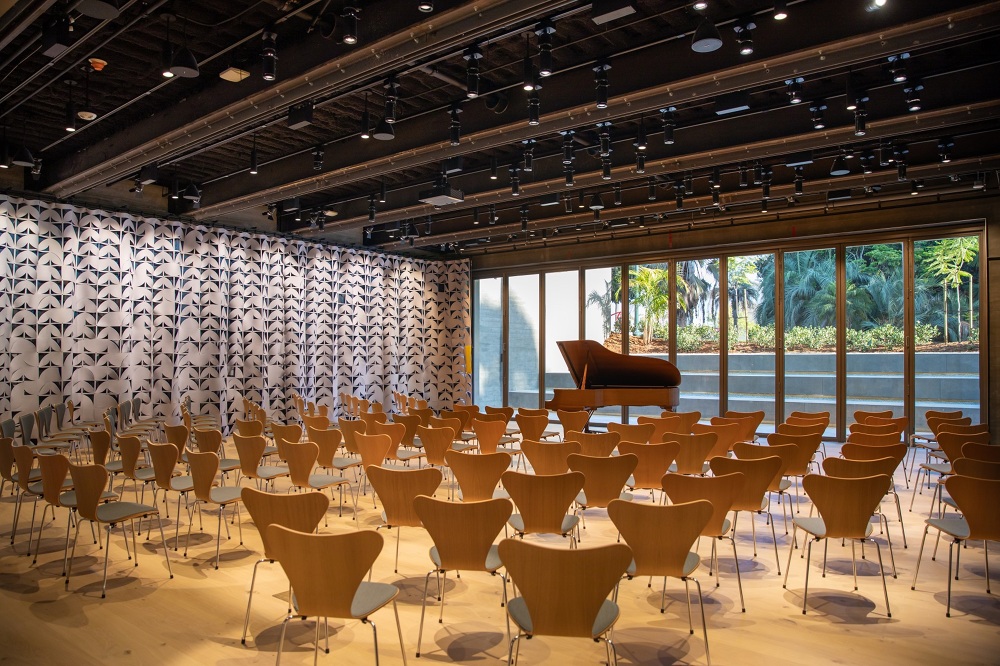
Sessions is a billowing, layered curtain installation that flows along the entire length of the 40-foot retractable glass facade in the new, multipurpose theater of Mingei International Museum.
SCALE: Do you make sure to include the local craftsmen in your work?
PETRA BLAISSE: In this case only the track and motor craftsmen were local; the curtain itself was made in The Netherlands – by ourselves in collaboration with different production companies. But sometimes, such as now in a new project in Tijuana, Mexico, we do want to work with only local companies and craftspeople.
SCALE: What next for the firm? What or who or for which project would you aspire to work?
PETRA BLAISSE: We are doing research in both directions of our work: we are developing a visual communication language for our main focus: VITAL SOIL – so as to involve and educate clients, architects, builders, residents young and old on the importance (and beauty) of living soil in our urban environment (and in agriculture); and we are researching ways to create curtains that collect solar energy; or exterior curtains that absorb moisture, spores and seeds to act as base for living organisms: mosses, fungi, ferns; insects and other small life forms.
Short Takes:
The First Project
Nederlands Dans Theater (interiors and stage curtain, 1986-1987) and the OMA exhibitions internationally (1989-1992).
The Work that you Hold Special
Curtains: LocHal curtains, Tilburg (2019); Narcissus helium-held voile. Gardens: Biblioteca degli Alberi; Qatar Foundation Headquarters; Qatar National Library – mineral garden. Exhibitions: MAXXI museum Rome “ A Story for the Future – 10 years MAXXI”; Humboldt University exhibit “Nach der Natur” at Humboldt Forum, Berlin.
How do you keep yourself updated with the design world?
I don’t, but my partners and colleagues do: by reading magazines, following internet & social media.
Your Mentor
My partner and many writers and creators.
A Quote that is your Life Motto
“You have to act as if it were possible to radically transform the world. And you have to do it all the time” (Angela Davis)
For or against social media?
For, as long as I don’t need to be part of it or spend time on it; and as long as I can take my own time to develop ideas and to formulate/think about appropriate /constructive responses.
All Images Courtesy Inside Outside




